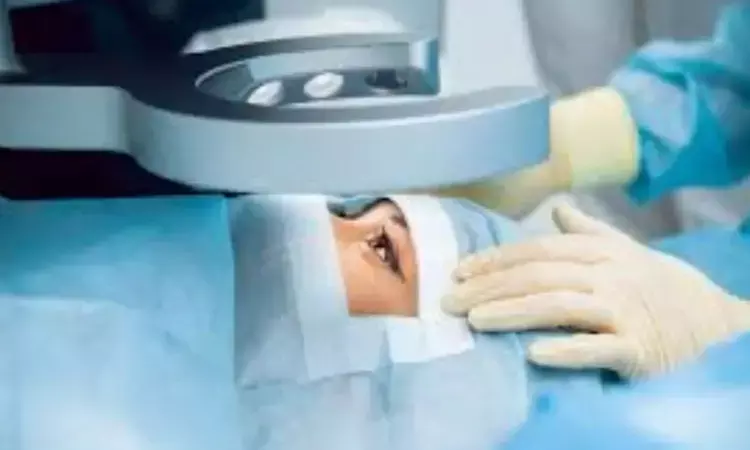- Home
- Medical news & Guidelines
- Anesthesiology
- Cardiology and CTVS
- Critical Care
- Dentistry
- Dermatology
- Diabetes and Endocrinology
- ENT
- Gastroenterology
- Medicine
- Nephrology
- Neurology
- Obstretics-Gynaecology
- Oncology
- Ophthalmology
- Orthopaedics
- Pediatrics-Neonatology
- Psychiatry
- Pulmonology
- Radiology
- Surgery
- Urology
- Laboratory Medicine
- Diet
- Nursing
- Paramedical
- Physiotherapy
- Health news
- Fact Check
- Bone Health Fact Check
- Brain Health Fact Check
- Cancer Related Fact Check
- Child Care Fact Check
- Dental and oral health fact check
- Diabetes and metabolic health fact check
- Diet and Nutrition Fact Check
- Eye and ENT Care Fact Check
- Fitness fact check
- Gut health fact check
- Heart health fact check
- Kidney health fact check
- Medical education fact check
- Men's health fact check
- Respiratory fact check
- Skin and hair care fact check
- Vaccine and Immunization fact check
- Women's health fact check
- AYUSH
- State News
- Andaman and Nicobar Islands
- Andhra Pradesh
- Arunachal Pradesh
- Assam
- Bihar
- Chandigarh
- Chattisgarh
- Dadra and Nagar Haveli
- Daman and Diu
- Delhi
- Goa
- Gujarat
- Haryana
- Himachal Pradesh
- Jammu & Kashmir
- Jharkhand
- Karnataka
- Kerala
- Ladakh
- Lakshadweep
- Madhya Pradesh
- Maharashtra
- Manipur
- Meghalaya
- Mizoram
- Nagaland
- Odisha
- Puducherry
- Punjab
- Rajasthan
- Sikkim
- Tamil Nadu
- Telangana
- Tripura
- Uttar Pradesh
- Uttrakhand
- West Bengal
- Medical Education
- Industry
NSAID effective in reducing pseudophakic cystoid macular edema post-operatively: Study

A new study published in the International Journal of Retina and Vitreous showed that nonsteroidal anti-inflammatory drugs (NSAIDs), either by themselves or in conjunction with steroids, have demonstrated effectiveness in lowering the incidence of pseudophakic cystoid macular edema (PCME) following surgery.
Optical coherence tomography (OCT) analysis of cystoid macular edema (CME) which is a well-known surgical consequence, reveals central subfield macular thickness, cystic hyporeflective lesions, and subfoveal fluid. CME that after cataract surgery is known as PCME. It is thought to be the most frequent reason for vision decline following surgery. The main theory for PCME is mechanical manipulation linked to the release of inflammatory mediators.
In order to successfully lower the incidence of PCME, no standardized preventive procedure has been developed as of yet. So, Abdullah Alqahtani and his colleagues evaluated the safety and effectiveness of corticosteroids and nonsteroidal anti-inflammatory drops in preventing PCME. This study included randomized controlled trials (RCTs) that examined the effectiveness of NSAID against placebo, steroid, or NSAID + steroid against placebo which indicated the prevalence of macular thickness, PCME, and best-corrected visual acuity.
This analysis included a total of 18 RCTs (n = 2959). 2 RCTs had a high risk of bias, 7 RCTs had an unknown risk of bias, and 9 RCTs had a low risk. NSAID-treated individuals had a considerably decreased incidence of cystoid macular edema (RR = 0.33, P < 0.001). According to subgroup analysis, individuals using NSAIDs alone had a statistically significant lower probability of developing edema than other patients (P < 0.001). NSAIDs were linked to noticeably lower mean corrected visual acuity values (P < 0.001) by using LogMar.
The findings from this systematic review and meta-analysis revealed that NSAIDs, either by themselves or in conjunction with steroids, are effective preventative interventions that can lower the incidence of PCME. However, a variety of circumstances, such as intraoperative problems, ocular or systemic disorders, and surgical manipulation, contribute to its pathogenesis. Standardized preventive procedures are therefore required for every patient group, including those who are healthy, have ocular disorders, and have systemic diseases.
Source:
Alqahtani, A. S., Hersi, R. M., Homsi, J. J., Alamoudi, L. O., Alghamdi, S., Alrajhi, R. K., & AlJehani, R. A. (2024). Prophylactic regimens for the prevention of pseudophakic cystoid macular edema: systematic review and meta-analysis. In International Journal of Retina and Vitreous (Vol. 10, Issue 1). Springer Science and Business Media LLC. https://doi.org/10.1186/s40942-024-00588-8
Neuroscience Masters graduate
Jacinthlyn Sylvia, a Neuroscience Master's graduate from Chennai has worked extensively in deciphering the neurobiology of cognition and motor control in aging. She also has spread-out exposure to Neurosurgery from her Bachelor’s. She is currently involved in active Neuro-Oncology research. She is an upcoming neuroscientist with a fiery passion for writing. Her news cover at Medical Dialogues feature recent discoveries and updates from the healthcare and biomedical research fields. She can be reached at editorial@medicaldialogues.in
Dr Kamal Kant Kohli-MBBS, DTCD- a chest specialist with more than 30 years of practice and a flair for writing clinical articles, Dr Kamal Kant Kohli joined Medical Dialogues as a Chief Editor of Medical News. Besides writing articles, as an editor, he proofreads and verifies all the medical content published on Medical Dialogues including those coming from journals, studies,medical conferences,guidelines etc. Email: drkohli@medicaldialogues.in. Contact no. 011-43720751


